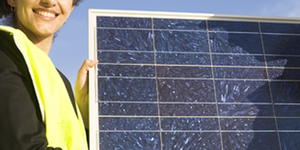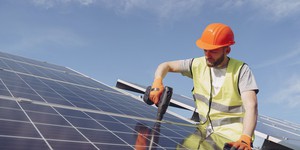Abstract
Solar cells are an alternative method for generating electricity directly from sunlight. With this project, you can get down to the atomic level and learn about the world of solid-state electronics as you investigate how solar cells work. Your experiment will measure the effect of changing light intensity on power output from the solar cell. A possible variation would be to investigate the effect of changing the color of the light.Summary
Andrew Olson, PhD, Science Buddies
Edited by Ben Finio, PhD, Science Buddies
Sources
This project is based on:
- Corlett, N., 2003. "How Does the Intensity of Light Affect Output of Solar Cells?," California State Science Fair Abstract.
Objective
The goal of this experiment is to determine how changes in incoming light intensity affect the output of solar cells.
Introduction
Solar cells are electronic devices that can transform light energy into an electric current. Solar cells are semiconductor devices, meaning that they have properties that are intermediate between a conductor and an insulator. When light of the right wavelength shines on the semiconductor material of a solar cell, the light creates a flow of electrons. This is known as the photoelectric effect. Small solar cells, like the one used in this project, can be used in circuits to charge batteries, power a calculator, or light an LED (light emitting diode).
In this project, you will measure the open-circuit current and short-circuit voltage produced by a solar cell. How do you think these values will change if you change the brightness of a light bulb used to power the solar cell?
Terms and Concepts
To do this project, you should do research that enables you to understand the following terms and concepts:
- Semiconductor
- Solar cell (also called photovoltaic cell)
- Photoelectric effect
- Light emitting diode (LED)
- Lumens (unit of light intensity)
- Voltage (V)
- Current (I)
- Resistance (R)
- Open-circuit voltage
- Short-circuit current
- Power
Questions
- How do solar cells turn light into electricity?
Bibliography
- Solar Action Alliance. (n.d.). Solar 101/Basics. Retrieved August 10, 2016.
- Aldous, S. (2006). How Solar Cells Work HowStuffWorks.com. Retrieved December 13, 2006.
- NOVA. (2011, April 20). Power Surge. Retrieved April 11, 2013.
- Staff. (1999). Ohm's Law. Physics Department, University of Oregon. Retrieved December 13, 2006.
- Klipstein, Jr., D.L. (2006). The Great Internet Light Bulb Book, Part 1. Retrieved December 13, 2006.
- Hewes, J. (2006). Light Emitting Diodes (LEDs). The Electronics Club, Kelsey Park Sports College. Retrieved April 11, 2013.
Materials and Equipment
Some of the components needed for this project are available from Jameco Electronics:
- 6 V, 150 mA solar cell with alligator clip leads, part #2260041
- Digital multimeter. See our multimeter tutorial if you do not know how to use a multimeter.
- clamp-on lamp with reflector, rated for at least 150 W bulbs (available at your local hardware store),
- At least three light bulbs with different wattages (e.g. 50, 100, and 150 W).
- Note: the suggested wattages are for incandescent bulbs. If you purchase compact fluorescent (CFL) or light-emitting diode (LED) bulbs, their actual wattages will be lower, but they will display an "equivalent" wattage on the package. While solar panels work best with incandescent bulbs (due to the spectrum of light emitted), for purposes of this science project, you should still be able to use CFL or LED bulbs.
Disclaimer: Science Buddies participates in affiliate programs with Home Science Tools, Amazon.com, Carolina Biological, and Jameco Electronics. Proceeds from the affiliate programs help support Science Buddies, a 501(c)(3) public charity, and keep our resources free for everyone. Our top priority is student learning. If you have any comments (positive or negative) related to purchases you've made for science projects from recommendations on our site, please let us know. Write to us at scibuddy@sciencebuddies.org.
Experimental Procedure
- Set up your experiment as shown in Figure 1.
- Connect the multimeter probes to the solar cell's alligator clip leads. If you need help using a multimeter, check out the Science Buddies reference How to Use a Multimeter.
- Set up the lamp a fixed height above the solar cell on a flat surface. The exact distance does not matter as long as you keep it consistent throughout the experiment (for example, 30 cm).
Figure 1. Experimental setup for this project.
- Prepare a data table in your lab notebook to record light bulb wattage, brightness in lumens (this information should be available on the light bulb package), open-circuit voltage, and short-circuit current for the solar cell.
- Insert your lowest-wattage bulb into the lamp.
- Take at least three readings of the open-circuit voltage of the solar cell and record them in your lab notebook.
- Take at least three readings of the short-circuit current of the solar cell and record them in your lab notebook.
- Insert your next highest-wattage bulb into the lamp and repeat steps 4–5.
- Repeat steps 4–5 for each of your remaining bulbs.
- Calculate average values for each set of recordings in your data table.
- Make two scatter plots, one of open-circuit voltage vs. bulb brightness in lumens, and one of short-circuit current vs. bulb brightness in lumens. How does the solar cell output change as the brightness of the light changes? Does this match your predictions?
Ask an Expert
Global Connections
The United Nations Sustainable Development Goals (UNSDGs) are a blueprint to achieve a better and more sustainable future for all.
Variations
- This project has you measure open-circuit voltage and short-circuit current, which are the maximum values the solar cell can supply. In reality, which the solar cell is attached to a load, both of those values will drop. Attach the solar cell to a fixed load like a resistor, and repeat the experiment. Calculate the power output of the solar cell (power = current × voltage, or P=IV) under load. How does the power output change with bulb brightness?
- For more advanced students, can you devise a way to figure out the internal resistance of the solar cell? Is the internal resistance constant, or does it vary with incident light intensity?
- Test solar cell power output as a function of the angle of the incoming light. Keep the distance and brightness of the light source constant, but vary the angle of the incoming light.
- Another variation would be to measure the power output of the solar cell as a function of the ambient temperature (see the Science Buddies project A Cool Way to Make Electricity: Solar Cell Power Output vs. Temperature.
- A more advanced project idea would be to measure the power output of the solar cell as a function of the color of the incoming light. You should do background research to learn how light energy varies with wavelength (color). You will also need to know the spectral (color) characteristics of your light source. For this reason, it would be a good idea to use sunlight for this project. You can get a booklet with 100 color filters for about $10 plus shipping. A search on "color filter booklet" should turn up multiple sources.
Careers
If you like this project, you might enjoy exploring these related careers:











